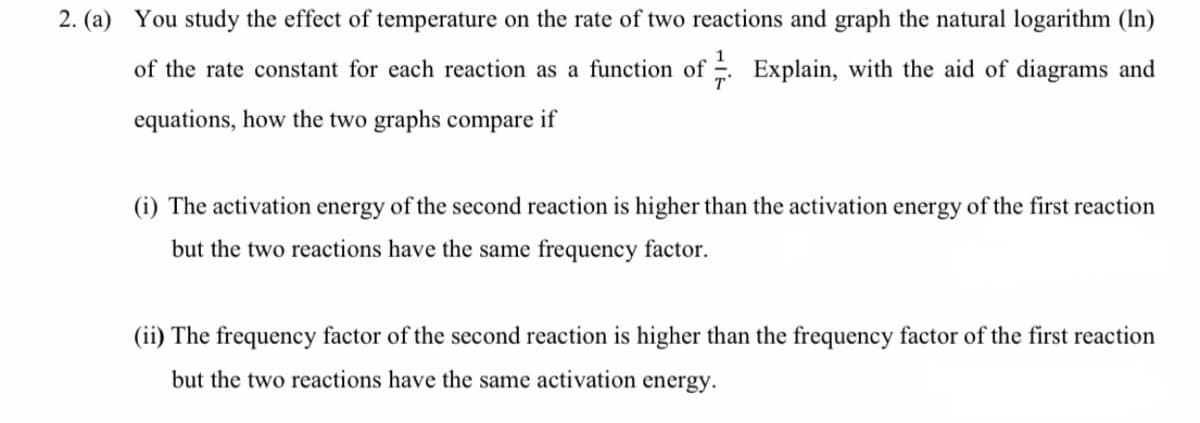2. (a) You study the effect of temperature on the rate of two reactions and graph the natural logarithm (In) of the rate constant for each reaction as a function of Explain, with the aid of diagrams and equations, how the two graphs compare if (i) The activation energy of the second reaction is higher than the activation energy of the first reaction but the two reactions have the same frequency factor. (ii) The frequency factor of the second reaction is higher than the frequency factor of the first reaction but the two reactions have the same activation energy.
2. (a) You study the effect of temperature on the rate of two reactions and graph the natural logarithm (In) of the rate constant for each reaction as a function of Explain, with the aid of diagrams and equations, how the two graphs compare if (i) The activation energy of the second reaction is higher than the activation energy of the first reaction but the two reactions have the same frequency factor. (ii) The frequency factor of the second reaction is higher than the frequency factor of the first reaction but the two reactions have the same activation energy.
Chemistry: The Molecular Science
5th Edition
ISBN:9781285199047
Author:John W. Moore, Conrad L. Stanitski
Publisher:John W. Moore, Conrad L. Stanitski
Chapter11: Chemical Kinetics: Rates Of Reactions
Section: Chapter Questions
Problem 52QRT
Related questions
Question

Transcribed Image Text:2. (a) You study the effect of temperature on the rate of two reactions and graph the natural logarithm (In)
of the rate constant for each reaction as a function of Explain, with the aid of diagrams and
equations, how the two graphs compare if
(i) The activation energy of the second reaction is higher than the activation energy of the first reaction
but the two reactions have the same frequency factor.
(ii) The frequency factor of the second reaction is higher than the frequency factor of the first reaction
but the two reactions have the same activation energy.
Expert Solution
This question has been solved!
Explore an expertly crafted, step-by-step solution for a thorough understanding of key concepts.
This is a popular solution!
Trending now
This is a popular solution!
Step by step
Solved in 2 steps with 3 images

Knowledge Booster
Learn more about
Need a deep-dive on the concept behind this application? Look no further. Learn more about this topic, chemistry and related others by exploring similar questions and additional content below.Recommended textbooks for you

Chemistry: The Molecular Science
Chemistry
ISBN:
9781285199047
Author:
John W. Moore, Conrad L. Stanitski
Publisher:
Cengage Learning

Chemistry by OpenStax (2015-05-04)
Chemistry
ISBN:
9781938168390
Author:
Klaus Theopold, Richard H Langley, Paul Flowers, William R. Robinson, Mark Blaser
Publisher:
OpenStax

Chemistry: Principles and Practice
Chemistry
ISBN:
9780534420123
Author:
Daniel L. Reger, Scott R. Goode, David W. Ball, Edward Mercer
Publisher:
Cengage Learning

Chemistry: The Molecular Science
Chemistry
ISBN:
9781285199047
Author:
John W. Moore, Conrad L. Stanitski
Publisher:
Cengage Learning

Chemistry by OpenStax (2015-05-04)
Chemistry
ISBN:
9781938168390
Author:
Klaus Theopold, Richard H Langley, Paul Flowers, William R. Robinson, Mark Blaser
Publisher:
OpenStax

Chemistry: Principles and Practice
Chemistry
ISBN:
9780534420123
Author:
Daniel L. Reger, Scott R. Goode, David W. Ball, Edward Mercer
Publisher:
Cengage Learning

Chemistry for Engineering Students
Chemistry
ISBN:
9781337398909
Author:
Lawrence S. Brown, Tom Holme
Publisher:
Cengage Learning

Chemistry: Principles and Reactions
Chemistry
ISBN:
9781305079373
Author:
William L. Masterton, Cecile N. Hurley
Publisher:
Cengage Learning
